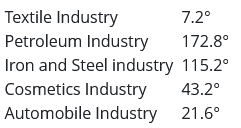Year :
2019
Title :
Geography
Exam :
JAMB Exam
Paper 1 | Objectives
41 - 50 of 78 Questions
| # | Question | Ans |
|---|---|---|
|
|
||
| 41. |
Table: A. 25,000 B. 12,000 C. 3,000 D. 10,000 |
B |
| 42. |
Table: A. 0.32 B. 0.06 C. 0.12 D. 0.26 |
A |
| 43. |
The annual rainfall along the coast is less than expected in the equitorial region because of the A. presence of a cold current B. configuration of the coastline C. high altitude of the area D. subsidence of air masses |
D |
| 44. |
Kano is a major population centre in Nigeria because its A. Early religious and economic significance B. Conducive climate for groundnut production C. Early industrial development D. Large population of Hausa-speaking indigenes |
A |
| 45. |
The Sudd region has been highly valued for its A. large scale irrigation B. mineral deposits C. fishing industry D. biodiversity |
D |
| 46. |
The ferralitic soils in West Africa are mostly found in the A. Swampy coastline B. Forest belt C. Desert Environment D. Savanna belt |
B |
| 47. |
A common feature of forcados, Bonny and Eket in the Niger delta is that they are A. Very important fishing ports B. Terminal for oil companies C. Important for natural gas exports D. Export processing zones |
B |
| 48. |
The Nigerian town which owed much of their growth in the 20th century to the development of the railway include A. Lagos, Minna, Nnewi and Gusau B. Lagos, Lokoja, Gusau, Umuahia C. Osogbo, Minna, Owerri and Jos D. Enugu, Jos, Kaduna, Minna |
D |
| 49. |
Sugar Plantations in Africa are most highly developed in the lowlands of A. the Guinea Coast and Mozambique B. the mediterranean seaboard and the Guinea coast C. Mozambique and Natal D. Natal and Lower Nile |
C |
| 50. |
The Harbel Plantation in Liberia is noted for large-scale production of A. oil palm B. rubber C. cocoa D. coffee |
B |
|
|
||
| 41. |
Table: A. 25,000 B. 12,000 C. 3,000 D. 10,000 |
B |
| 42. |
Table: A. 0.32 B. 0.06 C. 0.12 D. 0.26 |
A |
| 43. |
The annual rainfall along the coast is less than expected in the equitorial region because of the A. presence of a cold current B. configuration of the coastline C. high altitude of the area D. subsidence of air masses |
D |
| 44. |
Kano is a major population centre in Nigeria because its A. Early religious and economic significance B. Conducive climate for groundnut production C. Early industrial development D. Large population of Hausa-speaking indigenes |
A |
| 45. |
The Sudd region has been highly valued for its A. large scale irrigation B. mineral deposits C. fishing industry D. biodiversity |
D |
| 46. |
The ferralitic soils in West Africa are mostly found in the A. Swampy coastline B. Forest belt C. Desert Environment D. Savanna belt |
B |
| 47. |
A common feature of forcados, Bonny and Eket in the Niger delta is that they are A. Very important fishing ports B. Terminal for oil companies C. Important for natural gas exports D. Export processing zones |
B |
| 48. |
The Nigerian town which owed much of their growth in the 20th century to the development of the railway include A. Lagos, Minna, Nnewi and Gusau B. Lagos, Lokoja, Gusau, Umuahia C. Osogbo, Minna, Owerri and Jos D. Enugu, Jos, Kaduna, Minna |
D |
| 49. |
Sugar Plantations in Africa are most highly developed in the lowlands of A. the Guinea Coast and Mozambique B. the mediterranean seaboard and the Guinea coast C. Mozambique and Natal D. Natal and Lower Nile |
C |
| 50. |
The Harbel Plantation in Liberia is noted for large-scale production of A. oil palm B. rubber C. cocoa D. coffee |
B |
